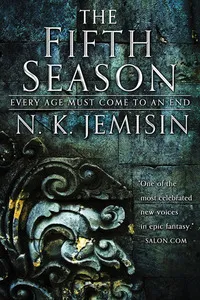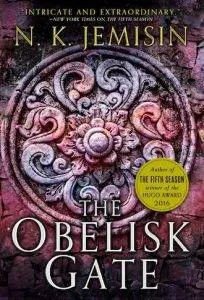
How Trauma Bonds Drive the BROKEN EARTH Trilogy
This content contains affiliate links. When you buy through these links, we may earn an affiliate commission.
(Note: this essay contains spoilers for the Broken Earth trilogy and details of physical, medical, and emotional abuse of children in fiction.)
N. K. Jemisin’s Hugo- and Nebula-winning Broken Earth series is one of my favorite works of fantasy. It’s a cohesive, diverse, fully developed world, with its own races, geography, mythology, and much more. In a post-apocalyptic world with an unstable climate, people called orogenes can harness energy to control volcanoes and earthquakes. The oppression of the orogenes has many possible parallels to real-world colonialism and racism and produces complex relationships with huge power imbalances.
 Orogenes are often abused, abandoned, or murdered by non-orogene relatives, who fear their powers. In the first book, The Fifth Season, a gifted young orogene girl named Damaya is abandoned by her parents to the care of a man named Schaffa. He is a Guardian, part of a social class charged with controlling and training orogenes. Schaffa seems like a benevolent teacher and father figure—until he deliberately breaks Damaya’s hand! Schaffa and Damaya travel from her home to the Fulcrum, a school where orogenes receive strict training. In the second and third books, The Obelisk Gate and The Stone Sky, Schaffa is Guardian to Nassun, Damaya’s equally gifted and independent daughter. (As an adult, Damaya’s name is now Essun.) Although he’s vowed never to hurt another child, Schaffa and Nassun’s relationship still shows classic signs of trauma bonding: an unhealthy but intense connection to a dangerous person.
Orogenes are often abused, abandoned, or murdered by non-orogene relatives, who fear their powers. In the first book, The Fifth Season, a gifted young orogene girl named Damaya is abandoned by her parents to the care of a man named Schaffa. He is a Guardian, part of a social class charged with controlling and training orogenes. Schaffa seems like a benevolent teacher and father figure—until he deliberately breaks Damaya’s hand! Schaffa and Damaya travel from her home to the Fulcrum, a school where orogenes receive strict training. In the second and third books, The Obelisk Gate and The Stone Sky, Schaffa is Guardian to Nassun, Damaya’s equally gifted and independent daughter. (As an adult, Damaya’s name is now Essun.) Although he’s vowed never to hurt another child, Schaffa and Nassun’s relationship still shows classic signs of trauma bonding: an unhealthy but intense connection to a dangerous person.
 When Essun realizes that Nassun is with Schaffa, she thinks that her daughter is “in the hands of a monster” (TSS 164). Even Essun acknowledges that if Nassun loves him, “Nassun’s Schaffa” must seem like a different person now. In one of the biggest ironies of the series, someone who traumatized Essun now protects her daughter.
Nassun and Schaffa’s relationship contains a lot of projection and transference. Each ascribes or projects their own feelings onto the other. Each also represents important people the other has lost. Nassun sees Schaffa as her replacement father. Because he hated and feared orogenes, Nassun’s father, Jija, murdered her brother and tried to kill her. She tells Schaffa, “You’re my new father” (TSS 199). For Schaffa, Nassun represents the generations of orogene children whom he cared for, tried to protect, but abused as a Guardian at the Fulcrum. When he realizes that her mother is his other favorite, Damaya, their bond deepens.
Like many dangerous or abusive people, Schaffa can be very manipulative. He gives Nassun the parental affection that she craves, and they apparently care deeply each other. Like with her mother before her, he knows Nassun is especially gifted, and other students notice his favoritism. When she says Schaffa’s the only person who loves and accepts her, he agrees. Nassun once calls herself a monster, and he replies that she’s “my monster” (TOG 198). Schaffa vows never to hurt a child again, physically, but this is a textbook emotional abuse tactic. Possessive, controlling people often convince their targets they’re the only person who loves or understands them.
In the second and third books, readers learn how Guardians are created. Though not orogenes themselves, they have genetic relatives who are orogenes. As children, they’re taken from their families and given a metal brain implant. The implant, called a corestone, enables them to detect and control orogenes. Like the other characters, Schaffa is the product of personal and generational trauma. The implant controls him and causes him pain if he doesn’t harshly control orogenes.
When Essun realizes that Nassun is with Schaffa, she thinks that her daughter is “in the hands of a monster” (TSS 164). Even Essun acknowledges that if Nassun loves him, “Nassun’s Schaffa” must seem like a different person now. In one of the biggest ironies of the series, someone who traumatized Essun now protects her daughter.
Nassun and Schaffa’s relationship contains a lot of projection and transference. Each ascribes or projects their own feelings onto the other. Each also represents important people the other has lost. Nassun sees Schaffa as her replacement father. Because he hated and feared orogenes, Nassun’s father, Jija, murdered her brother and tried to kill her. She tells Schaffa, “You’re my new father” (TSS 199). For Schaffa, Nassun represents the generations of orogene children whom he cared for, tried to protect, but abused as a Guardian at the Fulcrum. When he realizes that her mother is his other favorite, Damaya, their bond deepens.
Like many dangerous or abusive people, Schaffa can be very manipulative. He gives Nassun the parental affection that she craves, and they apparently care deeply each other. Like with her mother before her, he knows Nassun is especially gifted, and other students notice his favoritism. When she says Schaffa’s the only person who loves and accepts her, he agrees. Nassun once calls herself a monster, and he replies that she’s “my monster” (TOG 198). Schaffa vows never to hurt a child again, physically, but this is a textbook emotional abuse tactic. Possessive, controlling people often convince their targets they’re the only person who loves or understands them.
In the second and third books, readers learn how Guardians are created. Though not orogenes themselves, they have genetic relatives who are orogenes. As children, they’re taken from their families and given a metal brain implant. The implant, called a corestone, enables them to detect and control orogenes. Like the other characters, Schaffa is the product of personal and generational trauma. The implant controls him and causes him pain if he doesn’t harshly control orogenes.
 The corestone makes Schaffa different from abusers in our world. Of course, this makes his actions no less traumatic to Damaya, who is now Essun. Breaking Damaya’s hand in the first book is not Schaffa’s sadistic impulse but an official Fulcrum policy that every student experiences. We readers can speculate that Schaffa might never have hurt children if not for his corestone, but the entire society is built on oppression. Schaffa demonstrates how easy it can be to pass trauma onto younger generations.
After Schaffa decides to disobey his corestone, he says that it drains his energy. As a uniquely powerful orogene, Nassun can sense this change in Schaffa and transfer some of her own energy or magic to him: “he’s not a parasite if she needs him, too, and if she gives what he will not take” (TSS 132). Nassun might not even remember that when they first met, Schaffa siphoned off small amounts of energy from her, hoping she wouldn’t notice. She might think the transfer was always her idea. The narrator tells us that in a few years, Nassun will describe this exchange as “symbiosis” (132). In psychological terms, this could also be called codependency. Unhealthy relationships often drain people’s energy or have unclear boundaries, just not so literally.
The intensity of an insular relationship with a dangerous person can prompt destructive, irrational decisions. Near the end of the trilogy, Nassun is faced with an impossible choice: irrevocably altering every person on Earth for a chance to save Schaffa’s life. After training and traveling to the other side of the world with him, Schaffa has become her whole world. Otherwise, she’d never prioritize him over everyone else, even herself and her mother.
The Broken Earth series presents truths about toxic relationships. By themselves, good intentions are not enough to make relationships safe. Schaffa thinks he loves Nassun and promises to protect her, but he remains extremely violent to other people. Because of their intensity, unsafe relationships and people often seem deeper and more important than safe ones. Nassun probably never would have been so bonded to Schaffa unless she already had trauma bonds to her parents. She wants Schaffa to fulfill all her emotional needs for parental love. Like many traumatized people, Nassun wants to prioritize an unsafe person over everyone else and do the impossible to keep him in her life.
The corestone makes Schaffa different from abusers in our world. Of course, this makes his actions no less traumatic to Damaya, who is now Essun. Breaking Damaya’s hand in the first book is not Schaffa’s sadistic impulse but an official Fulcrum policy that every student experiences. We readers can speculate that Schaffa might never have hurt children if not for his corestone, but the entire society is built on oppression. Schaffa demonstrates how easy it can be to pass trauma onto younger generations.
After Schaffa decides to disobey his corestone, he says that it drains his energy. As a uniquely powerful orogene, Nassun can sense this change in Schaffa and transfer some of her own energy or magic to him: “he’s not a parasite if she needs him, too, and if she gives what he will not take” (TSS 132). Nassun might not even remember that when they first met, Schaffa siphoned off small amounts of energy from her, hoping she wouldn’t notice. She might think the transfer was always her idea. The narrator tells us that in a few years, Nassun will describe this exchange as “symbiosis” (132). In psychological terms, this could also be called codependency. Unhealthy relationships often drain people’s energy or have unclear boundaries, just not so literally.
The intensity of an insular relationship with a dangerous person can prompt destructive, irrational decisions. Near the end of the trilogy, Nassun is faced with an impossible choice: irrevocably altering every person on Earth for a chance to save Schaffa’s life. After training and traveling to the other side of the world with him, Schaffa has become her whole world. Otherwise, she’d never prioritize him over everyone else, even herself and her mother.
The Broken Earth series presents truths about toxic relationships. By themselves, good intentions are not enough to make relationships safe. Schaffa thinks he loves Nassun and promises to protect her, but he remains extremely violent to other people. Because of their intensity, unsafe relationships and people often seem deeper and more important than safe ones. Nassun probably never would have been so bonded to Schaffa unless she already had trauma bonds to her parents. She wants Schaffa to fulfill all her emotional needs for parental love. Like many traumatized people, Nassun wants to prioritize an unsafe person over everyone else and do the impossible to keep him in her life.
 Orogenes are often abused, abandoned, or murdered by non-orogene relatives, who fear their powers. In the first book, The Fifth Season, a gifted young orogene girl named Damaya is abandoned by her parents to the care of a man named Schaffa. He is a Guardian, part of a social class charged with controlling and training orogenes. Schaffa seems like a benevolent teacher and father figure—until he deliberately breaks Damaya’s hand! Schaffa and Damaya travel from her home to the Fulcrum, a school where orogenes receive strict training. In the second and third books, The Obelisk Gate and The Stone Sky, Schaffa is Guardian to Nassun, Damaya’s equally gifted and independent daughter. (As an adult, Damaya’s name is now Essun.) Although he’s vowed never to hurt another child, Schaffa and Nassun’s relationship still shows classic signs of trauma bonding: an unhealthy but intense connection to a dangerous person.
Orogenes are often abused, abandoned, or murdered by non-orogene relatives, who fear their powers. In the first book, The Fifth Season, a gifted young orogene girl named Damaya is abandoned by her parents to the care of a man named Schaffa. He is a Guardian, part of a social class charged with controlling and training orogenes. Schaffa seems like a benevolent teacher and father figure—until he deliberately breaks Damaya’s hand! Schaffa and Damaya travel from her home to the Fulcrum, a school where orogenes receive strict training. In the second and third books, The Obelisk Gate and The Stone Sky, Schaffa is Guardian to Nassun, Damaya’s equally gifted and independent daughter. (As an adult, Damaya’s name is now Essun.) Although he’s vowed never to hurt another child, Schaffa and Nassun’s relationship still shows classic signs of trauma bonding: an unhealthy but intense connection to a dangerous person.
 When Essun realizes that Nassun is with Schaffa, she thinks that her daughter is “in the hands of a monster” (TSS 164). Even Essun acknowledges that if Nassun loves him, “Nassun’s Schaffa” must seem like a different person now. In one of the biggest ironies of the series, someone who traumatized Essun now protects her daughter.
Nassun and Schaffa’s relationship contains a lot of projection and transference. Each ascribes or projects their own feelings onto the other. Each also represents important people the other has lost. Nassun sees Schaffa as her replacement father. Because he hated and feared orogenes, Nassun’s father, Jija, murdered her brother and tried to kill her. She tells Schaffa, “You’re my new father” (TSS 199). For Schaffa, Nassun represents the generations of orogene children whom he cared for, tried to protect, but abused as a Guardian at the Fulcrum. When he realizes that her mother is his other favorite, Damaya, their bond deepens.
Like many dangerous or abusive people, Schaffa can be very manipulative. He gives Nassun the parental affection that she craves, and they apparently care deeply each other. Like with her mother before her, he knows Nassun is especially gifted, and other students notice his favoritism. When she says Schaffa’s the only person who loves and accepts her, he agrees. Nassun once calls herself a monster, and he replies that she’s “my monster” (TOG 198). Schaffa vows never to hurt a child again, physically, but this is a textbook emotional abuse tactic. Possessive, controlling people often convince their targets they’re the only person who loves or understands them.
In the second and third books, readers learn how Guardians are created. Though not orogenes themselves, they have genetic relatives who are orogenes. As children, they’re taken from their families and given a metal brain implant. The implant, called a corestone, enables them to detect and control orogenes. Like the other characters, Schaffa is the product of personal and generational trauma. The implant controls him and causes him pain if he doesn’t harshly control orogenes.
When Essun realizes that Nassun is with Schaffa, she thinks that her daughter is “in the hands of a monster” (TSS 164). Even Essun acknowledges that if Nassun loves him, “Nassun’s Schaffa” must seem like a different person now. In one of the biggest ironies of the series, someone who traumatized Essun now protects her daughter.
Nassun and Schaffa’s relationship contains a lot of projection and transference. Each ascribes or projects their own feelings onto the other. Each also represents important people the other has lost. Nassun sees Schaffa as her replacement father. Because he hated and feared orogenes, Nassun’s father, Jija, murdered her brother and tried to kill her. She tells Schaffa, “You’re my new father” (TSS 199). For Schaffa, Nassun represents the generations of orogene children whom he cared for, tried to protect, but abused as a Guardian at the Fulcrum. When he realizes that her mother is his other favorite, Damaya, their bond deepens.
Like many dangerous or abusive people, Schaffa can be very manipulative. He gives Nassun the parental affection that she craves, and they apparently care deeply each other. Like with her mother before her, he knows Nassun is especially gifted, and other students notice his favoritism. When she says Schaffa’s the only person who loves and accepts her, he agrees. Nassun once calls herself a monster, and he replies that she’s “my monster” (TOG 198). Schaffa vows never to hurt a child again, physically, but this is a textbook emotional abuse tactic. Possessive, controlling people often convince their targets they’re the only person who loves or understands them.
In the second and third books, readers learn how Guardians are created. Though not orogenes themselves, they have genetic relatives who are orogenes. As children, they’re taken from their families and given a metal brain implant. The implant, called a corestone, enables them to detect and control orogenes. Like the other characters, Schaffa is the product of personal and generational trauma. The implant controls him and causes him pain if he doesn’t harshly control orogenes.
 The corestone makes Schaffa different from abusers in our world. Of course, this makes his actions no less traumatic to Damaya, who is now Essun. Breaking Damaya’s hand in the first book is not Schaffa’s sadistic impulse but an official Fulcrum policy that every student experiences. We readers can speculate that Schaffa might never have hurt children if not for his corestone, but the entire society is built on oppression. Schaffa demonstrates how easy it can be to pass trauma onto younger generations.
After Schaffa decides to disobey his corestone, he says that it drains his energy. As a uniquely powerful orogene, Nassun can sense this change in Schaffa and transfer some of her own energy or magic to him: “he’s not a parasite if she needs him, too, and if she gives what he will not take” (TSS 132). Nassun might not even remember that when they first met, Schaffa siphoned off small amounts of energy from her, hoping she wouldn’t notice. She might think the transfer was always her idea. The narrator tells us that in a few years, Nassun will describe this exchange as “symbiosis” (132). In psychological terms, this could also be called codependency. Unhealthy relationships often drain people’s energy or have unclear boundaries, just not so literally.
The intensity of an insular relationship with a dangerous person can prompt destructive, irrational decisions. Near the end of the trilogy, Nassun is faced with an impossible choice: irrevocably altering every person on Earth for a chance to save Schaffa’s life. After training and traveling to the other side of the world with him, Schaffa has become her whole world. Otherwise, she’d never prioritize him over everyone else, even herself and her mother.
The Broken Earth series presents truths about toxic relationships. By themselves, good intentions are not enough to make relationships safe. Schaffa thinks he loves Nassun and promises to protect her, but he remains extremely violent to other people. Because of their intensity, unsafe relationships and people often seem deeper and more important than safe ones. Nassun probably never would have been so bonded to Schaffa unless she already had trauma bonds to her parents. She wants Schaffa to fulfill all her emotional needs for parental love. Like many traumatized people, Nassun wants to prioritize an unsafe person over everyone else and do the impossible to keep him in her life.
The corestone makes Schaffa different from abusers in our world. Of course, this makes his actions no less traumatic to Damaya, who is now Essun. Breaking Damaya’s hand in the first book is not Schaffa’s sadistic impulse but an official Fulcrum policy that every student experiences. We readers can speculate that Schaffa might never have hurt children if not for his corestone, but the entire society is built on oppression. Schaffa demonstrates how easy it can be to pass trauma onto younger generations.
After Schaffa decides to disobey his corestone, he says that it drains his energy. As a uniquely powerful orogene, Nassun can sense this change in Schaffa and transfer some of her own energy or magic to him: “he’s not a parasite if she needs him, too, and if she gives what he will not take” (TSS 132). Nassun might not even remember that when they first met, Schaffa siphoned off small amounts of energy from her, hoping she wouldn’t notice. She might think the transfer was always her idea. The narrator tells us that in a few years, Nassun will describe this exchange as “symbiosis” (132). In psychological terms, this could also be called codependency. Unhealthy relationships often drain people’s energy or have unclear boundaries, just not so literally.
The intensity of an insular relationship with a dangerous person can prompt destructive, irrational decisions. Near the end of the trilogy, Nassun is faced with an impossible choice: irrevocably altering every person on Earth for a chance to save Schaffa’s life. After training and traveling to the other side of the world with him, Schaffa has become her whole world. Otherwise, she’d never prioritize him over everyone else, even herself and her mother.
The Broken Earth series presents truths about toxic relationships. By themselves, good intentions are not enough to make relationships safe. Schaffa thinks he loves Nassun and promises to protect her, but he remains extremely violent to other people. Because of their intensity, unsafe relationships and people often seem deeper and more important than safe ones. Nassun probably never would have been so bonded to Schaffa unless she already had trauma bonds to her parents. She wants Schaffa to fulfill all her emotional needs for parental love. Like many traumatized people, Nassun wants to prioritize an unsafe person over everyone else and do the impossible to keep him in her life.








